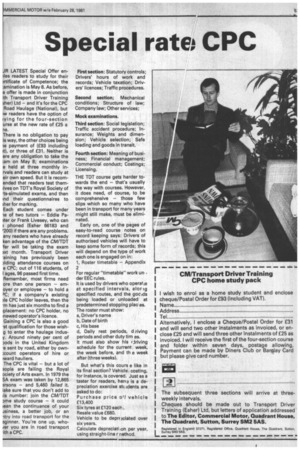Special rate CPC
Page 55

If you've noticed an error in this article please click here to report it so we can fix it.
JR LATEST Special Offer en;les readers to study for their :rtificate of Competence; the :amination is May 8. As before, e offer is made in conjunction ith Transport Driver Training Iher) Ltd — and it's for the CPC Road Haulage (National), but rw readers have the option of lying for the four-section urse at the new rate of E25 a There is no obligation to pay is way, the other choices being le payment of (£93 including it), or three of £31. Neither is ere any obligation to take the :am on May 8; examinations e held at three monthly inrvals and readers can study at eir own speed. But it is recomended that readers test them:Ives on TDT's Royal Society of Is-simulated exams, and then !nd their questionnaires to ;her for marking.
Each student comes under le of two tutors — Eddie Pa:ter or Frank Livesey, who can phoned (Esher 66183 and r200) if there are any problems. any readers who have already ken advantage of the CM/TOT fer will be taking the exam .:xt month. Transport Driver zining has previously been aiding attendance courses on e CPC; out of 116 students, of I ages, 96 passed first time.
Remember, most firms need ore than one person — emoyer or employee — to hold a 3C; if a company's existing ;le CPC holder leaves, then the -m has just six months to find a :placement: no CPC holder, no ,newed operator's licence.
Gaining a CPC is also a good -st qualification for those wishg to enter the haulage indusy. Around ninety per cent of Dods in the United Kingdom -e sent by road, either by own;count operators of hire or :ward hauliers.
The CPC is vital — but a lot of aciple are failing the Royal aciety of Arts exam. In 1979 the SA exam was taken by 12,865 arsons — and 5,460 failed it. lake sure that you don't add to us number: join the CM/TDT 3me study course — it could lean the continuance of your Airless, a better job, or an -lin/ into road transport for the 3ginner. You're one up, whorer you are in road transport ith a CPC.
First section: Statutory controls; Drivers' hours of work and records; Vehicle taxation; Drivers' licences; Traffic procedures.
Second section; Mechanical conditions; Structure of law; Company law; Other services; Mock examinations.
Third section: Social legislation; Traffic accident procedure; Insurance; Weights and dimension; Vehicle selection; Safe loading and goods in transit.
Fourth section: Meaning of business; Financial management; Commercial conduct; Costings; Licensing.
THE TOT course gets harder towards the end — that's usually the way with courses. However, it does need, of course, to be comprehensive — those few slips which so many who have been in transport for many years might still make, must be eliminated.
Early on, one of the pages of easy-to-read course notes on record keeping says: Drivers of authorised vehicles will have to keep some form of records; this will depend on the type of work each one is engaged on in: 1, Roster timetable — Appendix 2
For regular "timetable" work under EEC rules.
It is used by drivers who operate at specified intervals, along specified routes, and the god •cls being loaded or unloaded at predetermined stopping places. The roster must show: a, Driver's name b, Date of birth c, His base d, Daily rest periods, d riving periods and other duty tim es.
It must also show his iriving schedule for the current, week, the week before, and th e week after (three weeks).
But what's this cours e like in its final section? Vehicle; costing, for instance, is covered. Just as a taster for readers, herQ, is a depreciation exercise steidents are asked to do: Purchase price oil' vehicle C13,400 Six tyres at £120 each I.
Resale value £680.
Vehicle to be deprociated over six years.
Calculate depreciation per year, using straight-line method.




























































































